Birding In The Parks During The Year Of The Bird
"Did you see that bird???"
It's a question frequently overheard in the National Park System. And it might be uttered more often this year, the Year of the Bird. So what birds might you see in the parks, and where should you go to see them? Here are some suggestions.
One of the most recognizable birds in the U.S., the northern cardinal male is easily identified by its bright red feathers, according to Interior Department birders. More discreet, females are pale brown with red tinges in the wings, tail and crest. Common in brushy habitats, they can often be seen feeding while hopping around on the ground looking for larvae, seeds and berries.
You can spot them in Shenandoah National Park in Virginia and along the Blue Ridge Parkway in Virginia and North Carolina, at Allegheny Portage Railroad National Historic Site in Pennsylvania, Apostle Islands National Lakeshore in Wisconsin, and Boston Harbor Islands National Recreation Area, among many other park units.
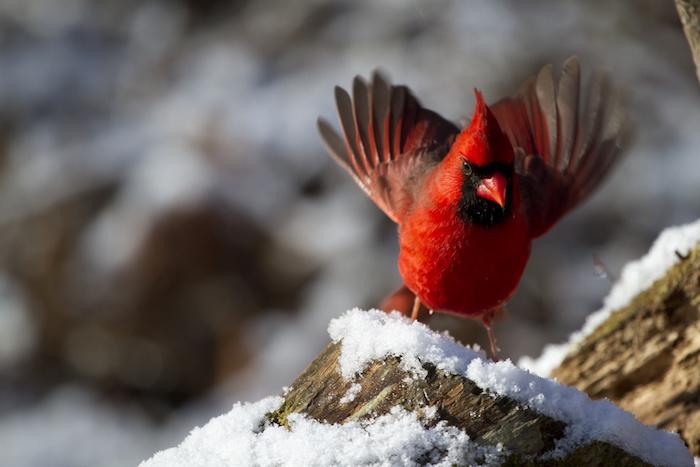
A northern cardinal at Shenandoah National Park in Virginia/NPS
A favorite of birdwatchers, the spritely yellow warbler might be small in size, but it makes up for it with its bright yellow feathers. One of more than 50 species of warblers found in North America, this delightful bird is often found flitting through river thickets, like those in Mississippi National River and Recreation Area in Minnesota. These small birds with the melodious song can also be found in Chesapeake and Ohio Canal National Historical Park in West Virginia and Maryland, at Gudalupe Mountains National Park in Texas, and a version, the California yellow warbler, has been documented at Lassen Volcanic National Park in California.

A yellow warbler perched on a branch at Yukon Delta National Wildlife Refuge in Alaska/Kristine Sowl, U.S. Fish and Wildlife Service.
Mountain bluebirds are one of the most recognized birds due to their distinct, vibrant blue feathers. This fascinating blue hue is due to the microscopic structure of the feathers reflecting sunlight in the same way that molecules of air make the sky look blue. Some folks believe it's a sign of good luck if a bluebird flies in front of you. Mountain bluebirds are found across the western U.S., arriving in the northern Rockies as a sign that spring has arrived and spending the winter months in the Southwest and Mexico. You can spot them at places like Craters of the Moon National Monument and Preserve in Idaho in the summer, Arches National Park in Utah, Badlands National Park in South Dakota, Rocky Mountain National Park in Colorado, Bighorn Canyon National Recreation Area in Wyoming and Montana, and even Cape Cod National Seashore in Massachusetts.
A Day In The Park: Biscayne National Park
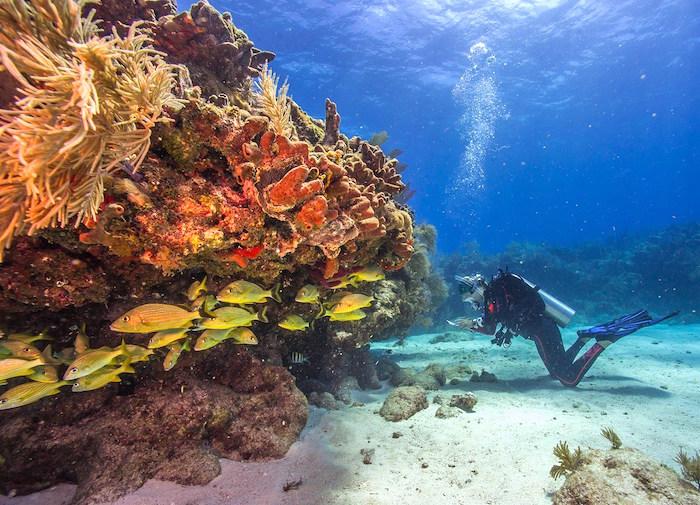
The wet underside of Biscayne National Park/NPS, Shaun Wolfe
A subtropical wilderness surrounded by urbanized Florida, Biscayne National Park is a tantalizing water world inviting you to get wet.
Though encompassing almost 173,000 acres, 95 percent of this shimmering jewel is under water, a fact that encourages visitors to don mask and fins for snorkeling or scuba, take to sea in a kayak, canoe, or sailboat, or spend the day fishing. For those who prefer to stay ashore, there's camping and picnicking available at Boca Chita Key and Elliott Key.
Hiking, not surprisingly in this watery park, is not high on anyone's list, The longest trail, on Elliott Key, runs just a mile. Though Biscayne has very little above-water land to explore, it nevertheless is a good place for birders, with a nice selection of neo-tropical water birds -- Mangrove cuckoo, Yellow-crowned night heron, Bananaquit, and more than a dozen warbler variations among the park's bird community -- to spot as you explore the Great Biscayne Birding Trail.
But if the marine side of the world fascinates you, Biscayne is a great place to visit. The park's reef system belongs to the world’s third-largest barrier reef system, the Florida Reef Tract, which extends from Fowey Rocks on Biscayne’s northern boundary to Loggerhead Reef on the western boundary of Dry Tortugas National Park.
What's certainly unique to the park system is Biscayne's Maritime Heritage Trail, an underwater route that leads you past six historic shipwrecks, with some dating back to the 19th century.

Erl King ran aground at Tennessee Reef on January 18, 1881.
However, when Biscayne was established, it was clear that preserving the park’s ecological, scenic, and cultural resources would be very difficult due to nearby Miami-Dade County, one of America’s larger urban regions. It comes as no surprise that Biscayne’s resources are in constant jeopardy. The park has been heavily impacted by chronic overfishing, boating accidents, disruption of natural water flow, pollution, and adjacent land-use activities.
Although there are many resource management challenges at Biscayne, the central, monumentally difficult one is preserving and restoring Biscayne’s coral reef system. This reef complex, which covers about half of the park, consists primarily of small patch reefs – about 4,000 in all – that are part of the Florida Keys chain. There are some transitional barrier reefs on the Atlantic (eastern) margin of the park.
The Park Service has been trying its best to protect that reef, and in 2015 park officials set aside 6 percent of the park for a marine reserve in a bid to restore and protect a stretch of the only tropical coral reef system in the continental United States. But that 10,502-acre reserve, which would be off-limits to fishing, has been under attack from the recreational fishing industry and Florida politicians.
Legislation proposed by U.S. Sen. Bill Nelson would require the Park Service go through formal consultation and coordination with the Fish and Wildlife Conservation Commission of the State of Florida. Additionally, the bill calls for science produced by the state of Florida to take precedence over the science the Park Service used to justify creation of the marine reserve.
While those lining up behind the senators say the marine reserve isn't needed, back in 2001 scientists warned that the park's fisheries were facing 'imminent collapse' without immediate help and protection. Additionally, by including 2,663 acres of coral reef in the preserve, the Park Service would contribute towards the U.S. Coral Reef Task Force's goal of having 20 percent of Florida's reefs within such reserves.
The challenge going forward is whether this marine park struggles to protect its resources and remain a gem in the National Park System.
"Biscayne has been overfished and over-stressed for decades. Experts at the National Park Service confirmed that Biscayne’s coral reefs are dying, and that some species are on the verge of collapse. Once plentiful native fish like mangrove snapper and black grouper are at record low levels of abundance and most are too small for anglers to keep," Caroline McLaughlin, the Biscayne program manager for the National Parks Conservation Associaton, told the Traveler in 2016. "In fact, recent studies show that a majority of snapper and grouper caught in the park are below state, federal, and international standards for sustainability."
So when you visit Biscayne, take a dive, marvel at the underwater treasures, but also take a moment to ponder the future of this magical place if better protections are not allowed.
Traveler's choice for: Snorkeling, scuba diving, kayaking, and birding.
A Day In The Park: Big Bend National Park

Big Bend National Park harbors a sprawling landscape rich in geology and so much more/Rebecca Latson
"Big" is a great descriptor for Big Bend National Park, where the park's more than 801,163 acres range from desert lands to mountain peaks and are rimmed on the south side by one of the country's great rivers.
Drive through the park deep in Texas and you'll come upon the vast expanse of the Chihuahuan Desert and the volcanic Chisos Mountains that were created from violent eruptions as well as uplift and erosion of an ancient seabed. As contributing photographer Rebecca Latson, herself a geologist, explains, "You’ll see textbook examples of volcanic and sedimentary geology, with some faulting and folding thrown in for good measure."
"There are many other enjoyable diversions in Big Bend," Ms. Latson wrote in her 3 Days In Big Bend National Park feature for Traveler's Essential Park Guide, Winter 2016. "You could explore the historic remains of the Sam Nail Ranch found along the Ross Maxwell Scenic Drive, soak in the 105-degree waters of the hot springs in the park’s Hot Springs Historic District where a bathhouse once stood, or simply relax."
"Situated about halfway between El Paso and Laredo, Big Bend is a vast swath of riverine corridor, high and rugged terrain, scenic canyons, and arid plains, Traveler's Bob Janiskee wrote in 2008. "Not merely big (the eighth-largest national park in the Lower 48), it is also remote in the true sense of the word. It’s not near any cities or transportation hubs, it’s not on the way to anything, and you really have to want to get there.
"Some say that Big Bend is the least known of all the National Park-designated units in the Lower 48. True or not, the place does have an image problem. Local Indians believed that this was a place where the Great Spirit stored rocks. When Spanish explorers encountered this area they simply called it 'the uninhabited land.' Today, relatively few Americans even know there’s a national park there."
But there is a national park there, and it's a fascinating place, rich in intriguing geology, visions of fortune that failed, and a magnet for birders, many who hope to spy the Colima warbler that flits up from Mexico to breed.
Big Bend is prevailingly sunny and warm, but temperature varies with both season and altitude and the weather can change very quickly (and sometimes dangerously) any time of year. Fall and spring weather is typically pleasant, and winter is usually mild. Summers are hot, as befits a subtropical desert, so if 100-degree heat is a turnoff you’ll probably want to avoid the hottest months (May and June) and do your leisure thing at the higher and cooler elevations if you visit during summer. During the rainy season, which brings frequent thunderstorms from mid-June to October, you need to watch out for flash floods and dangerous lightning.
When you do visit, find some time to leave your room after dark. Big Bend is a designated Gold Tier Dark Sky Park. According to the International Dark Sky Association, a “gold tier” designation means, “The full array of visible sky phenomena can be viewed—e.g. aurora, airglow, Milky Way, zodiacal light, and faint meteors.”
For the truly adventurous, head down to the Boquillas Border Crossing and cross the river by rowboat to Mexico for an afternoon.
Traveler's Choice For: Hiking, backpacking, floating the Rio Grand River, bird watching.
A Day In The Park: Arches National Park
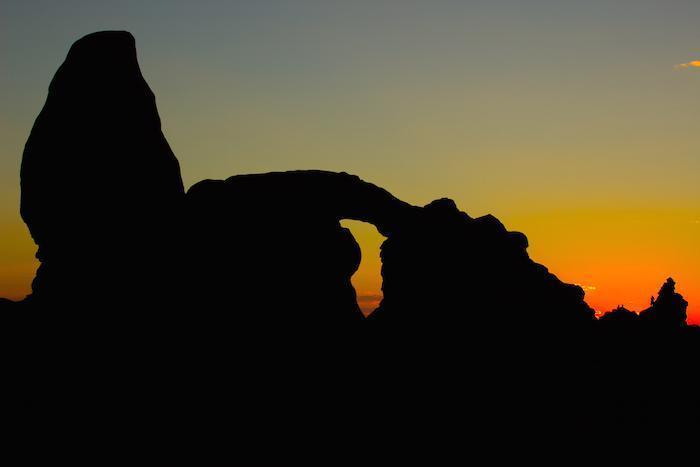
One of the most fantastic landscapes you'll explore is in Arches National Park/NPS, Kait Thomas
Arches National Park is one of the world's, not just one of the United States', most incredible national parks.
When you gaze at Balanced Rock, climb up into the Windows, or walk under Delicate Arch, it's hard to argue against that claim. The park's rock-itecture -- windows cut from stone, spindly arches longer than a football field, thin fins of rock -- and desertscape are otherworldly.
While Yellowstone National Park lays claim the world's largest collection of geothermal features, with some 10,000, Arches National Park holds the record for most nature-carved sandstone arches, with more than 2,000. Among them is Delicate Arch, which graces Utah license plates, and Landscape Arch, which somehow, despite its thin profile and 306-foot base-to-base span, continues to defy gravity.
Though blistering hot during the height of summer, Arches is a great stop in the fall and spring, and for those who don't mind winter's cold -- with little snow -- the solitude can be exquisite!
A park that those in a hurry can tour the highlights in half-a-day, Arches is much more rewarding to those who take the time to explore its nooks and crannies and savor its nuances. There are short, and long, hikes that cast this redrock desertscape in a variety of moods, a preserved log cabin built by a Civil War veteran to peer into, and Native American rock art that tells stories of earlier cultures that traipsed this redrock setting.
And here is where a chapter of American environmentalism was written, as the late Edward Abbey spent a season here as a ranger and worked on Desert Solitaire in a trailer not far from Balanced Rock.
The park is a gigantic playground for kids. It's rock outcrops are perfect for games of hide and seek, and there's even an official sandbox ... under, of course, Sand Dune Arch.
Traveler's Choice For: Families, kids, photography, hiking, geology
A Day In The Park: Acadia National Park
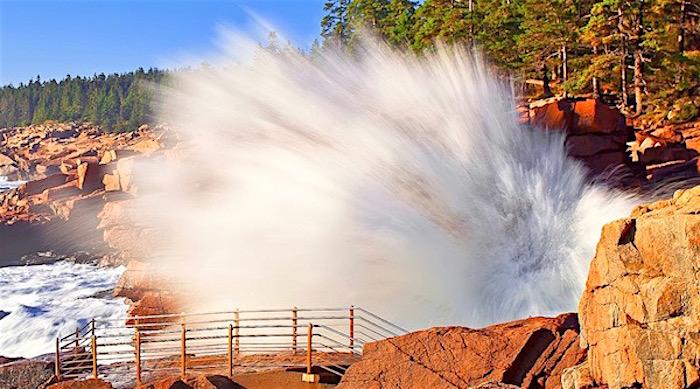
Thunder Hole is just one of the fascinations of Acadia National Park/Michael Rickard
"Raw, rugged, and surf-splashed" well define Acadia National Park, which at anchor in the Atlantic just off Maine's coast quite easily could also be described as a Yankee blue blood of the National Park System.
While its origins might indeed have had the blue blood of Rockefellers, Astors, and Morgans mixed into the mortar of its foundations, the park that welcomes all today is a refreshing mix of forested mountains and ocean-pounded coasts, of Downeast hospitality and architectural beauty, even of fresh lawbsta, delicious jam-smeared popovers, and afternoon tea.
Acadia is both a gentleman's (and gentlelady's) park where you can enjoy the setting of Jordon Pond over tea and the aforementioned popovers or take a horse-drawn carriage ride through the forests, and a playground for outdoors' enthusiasts. The park offers a wonderful array of activities, from pedaling your bike along the 48 miles of carriage paths that John D. Rockefeller paid for, searching tide pools for sea urchins, sea stars, and anemones, or traipsing up a trail that leads to sweeping views of Frenchman's Bay, the Gulf of Maine, and the Atlantic itself.
The ocean is decidedly cold here, perhaps too cold for an enjoyable swim. But there's great kayaking to be had in the waters that surround Mount Desert Island, and there are some ponds that are more conducive to swimming and canoeing.
Kids don't grow weary of Acadia, though they might grow tired from all the fresh air and outdoors activities. They can search for sea creatures in its tidal pools, go on a boat cruise and listen while a ranger discusses the natural and cultural history of the area, or learn about lobsters or birds of prey that nest on the island's cliffs.
Though small in size when compared to the Yellowstones, Yosemites, and even the Great Smokies of the National Park System, Acadia is never at a loss for ways to entertain you.
Traveler's Choice For: Hiking, tide pooling, biking, paddling, and birding.
Calling All Aspiring Paleontologists!
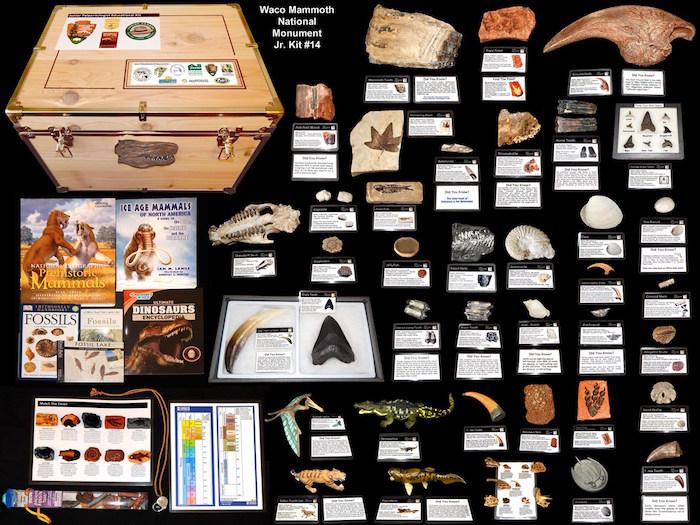
Junior Paleontologist Educational Kit developed for Waco Mammoth National Monument, Texas/Photo by Paul Roth for NPS
Over the past six years the Florida Paleontological Society, the Florida Geological Foundation, and the Florida Fossil Hunters have been working with many fossil groups around the state to produce a much needed resource to help the parks in their interpretation and presentation of Florida paleontology. Each year several fossil education kits have been produced, with club resources and member donations. These kits have been designed to complement the National Park Service's Junior Ranger’s Paleontology Program. They highlight the diverse paleontological resources of all our national parks, with a special emphasis on local paleontology.
So far the kits have been distributed to 17 national park units, mainly in Florida. The earliest kits have been in use and rotation since 2012 and have been a major component of each unit’s National Fossil Day Celebrations. It's hoped that these kits will become an integral part of each park's programming and educational outreach. A survey completed by each park with a Junior Paleontology kit shows that increasingly this is the case, and the hope is to expand the program to other regions of the country, and to expand outreach opportunities in paleontological education.

Examples of four identification/informational cards that accompany the fossil specimens/Photo by Paul Roth for NPS
The Kits:
The Junior Paleontologist Educational Kits are designed to be used in conjunction with the NPS "Junior Paleontologist Activity Booklet." Each kit contains real fossils or replicas that correspond with activities and items found in the Jr. Booklet. The core fossils in each kit are meant to represent the different types of fossils found in national parks. Some of the fossil material, mainly acquired through donations, has been a mammal jaw, coprolites, ferns, trace fossils (tracks), stromatolites, petrified wood, and many others. Including these with the kits allows the junior ranger to personally examine and hold real fossils. The replicas are used to augment the real fossils, especially in cases where cost or scarcity may be a factor. Also included are models of differing levels of sophistication, so that a wider age range audience can be reached. The kits include paleontological educational and reference books geared to appeal to different age groups and learning levels. These also allow for more in depth exploration by the junior ranger.
The Numbers:
The Jr. Kit project first began in 2012; since then, each year two to three kits have been produced and distributed to NPS units primarily within Florida. In that first year it was estimated that 365 kids completed the Jr. Paleontologist Ranger Program using those first kits. This mainly occurred at the first celebration of National Fossil Day at the Castillo de San Marcos National Monument. That original number has increased dramatically and in 2015 an estimated 2,300+ kids have earned their Junior Paleontologist Ranger Badge with the help of the Jr. Kits. The kits are also used in special in-park programs and local school system events, with an estimated 4,954 kids being reached in 2015.
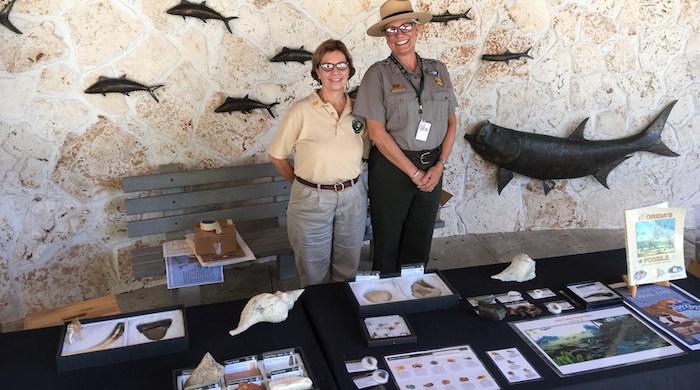
Biscayne National Park hosting a National Fossil Day event/NPS
Usage:
The Jr. Kits are still being used in the NPS Jr. Ranger education programs; however they are increasingly being used in other learning venues. They are also used in special in-park program days, for visiting school groups, are loaned to scout groups. Some have been incorporated into the park’s “traveling trunks” program, where educators at local schools can check out a thematic education trunk. They are used in National Fossil Day Celebrations throughout Florida, around Washington, D.C., and Denver, Colorado, where three other kits have been deployed. The kits are also being used by rangers in day camps, Earth Day festivals, summer camps, and centennial events.
Two Loggerhead Sea Turtles Brought Back To Health, Released At Canaveral National Seashore
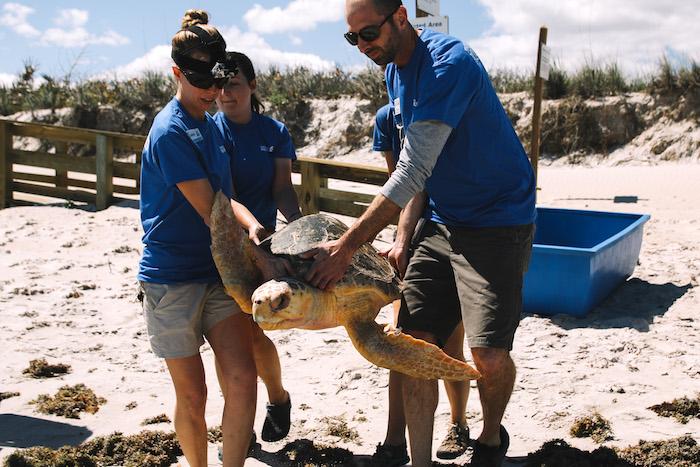
Having been nursed back to health, "Rosemary" was released into the Atlantic Ocean at Canaveral National Seashore in mid-March./The Florida Aquarium
In one of the year's feel good stories, two ailing loggerhead sea turtles have been nursed back to health at The Florida Aquarium's Center for Conservation and released back into the Atlantic Ocean at Canaveral National Seashore.
In June 2016, the first loggerhead, “Rosemary,” was found emaciated and lethargic at Cape Canaveral Air Force station. She was triaged by the local Brevard Zoo response team and then transferred to The Florida Aquarium for long-term rehabilitation. The Florida Aquarium Director of Animal Health Dr. Kathy Heym recalled, “When she arrived, her carapace and skin were covered with barnacles, and she was extremely anemic — a sign that she had been ill for a long time. Her blood sugar also was low indicating she wasn’t eating and likely had a systemic infection.”
In the months that followed, Dr. Heym and her team treated Rosemary with fluids, dextrose and antibiotics to correct immediate life-threatening issues. Her anemia was further treated with a blood transfusion from a rescued donor loggerhead named Li’l Herc at Sea World Orlando. After the transfusion, she started to turn the corner and began eating, gaining weight, and improving clinically. She currently weighs a whopping 130 pounds (males can reach up to 235 pounds!).
"Ginger," the second loggerhead sea turtle, was found in Northeast Atlantic waters by the New England Aquarium in December. She was flown to Tampa Executive Airport and then transported to The Florida Aquarium. The animal was triaged, meaning that blood samples and x-rays were taken and a full exam was conducted. Fortunately, no secondary issues from the cold-stunning were found, so aquarium experts provided her warm water temperatures, good nutrition and time to heal.
“She’s been eating great and gaining weight since her arrival," said Dr. Heym. "Now weighing over 80 pounds, Ginger is totally ready for the wild.”
The two turtles were released into the ocean on March 21.

After recovering from being "cold stunned" in the North Atlantic, "Ginger" was successfully treated at The Florida Aquarium and released at Canaveral National Seashore/The Florida Aquarium
“Collaboration between wildlife agencies and other zoological facilities is critical to saving endangered sea turtles, as is learning as much as possible as quickly as possible,” explained Margo McKnight, vice president of conservaiton, science, and research for The Florida Aquarium.
The Florida Aquarium is extensively involved in sea turtle conservation, including rescue and rehabilitation efforts. The aquarium's team will soon be working out of a 16,000+ square-foot Sea Turtle Hospital and Research Center now being built at the Aquarium’s Center for Conservation in Apollo Beach. This facility will house recovery, pre-release feeding, and deep diving pools to increase success of sea turtle survival post-release. The hospital suite will support health assessments on rescued animals as well as healthy turtles that are part of a wild population study.
”Loggerhead sea turtles are threatened in our waters, and endangered in other parts of the world," said Ms. McKnight. "We must do everything we can to protect them and restore their populations, including right here in Tampa Bay. We get so inspired every time we return these beautiful animals to the ocean for a second chance at survival.”
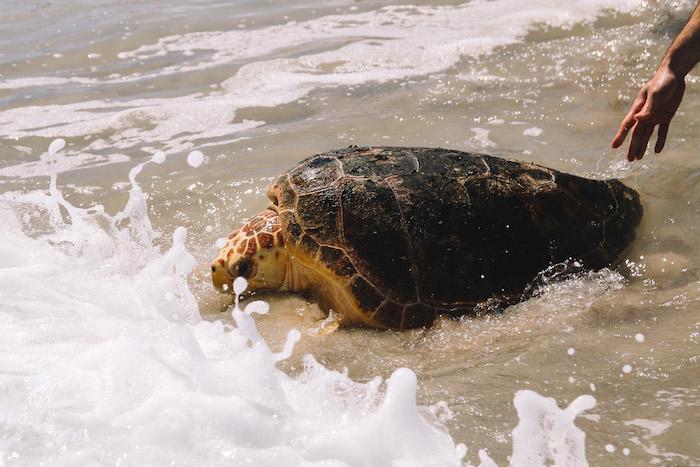
Free again!/The Florida Aquarium

Junior Ranger Night Explorer Program Expands To Obed Wild And Scenic River
With more and more units of the National Park System looking overhead at night to enjoy the dark night skies, the Junior Ranger Night Explorer program is expanding as well. One of the latest additions to this program, which rewards youngsters with a Junior Ranger patch for learning more about astronomy in the park, is Obed Wild and Scenic River in Tennessee.
Starry night skies are an important part of the special places the National Park Service protects. With the extent of urbanization in the United States, it is becoming exceedingly difficult to experience the night with little impact from artificial light pollution. At Obed, visitors can still enjoy the splendor of the Milky Way and see a night sky strewn with thousands of stars with only the naked eye.
The National Park Service’s Junior Ranger Night Explorer program includes an activity guide for youth ages 5-12 to encourage young visitors to explore the “dark side” of their park. Completion of the activity book, ideally during a night sky program, is rewarded with a unique patch.
Taking your family into the National Park System? This page will help you find articles, programs, and activities geared toward families and children.

A fossilized mammoth skull found at Channel Islands National Park is thought to be about 13,000 years old/NPS, Brent Sumner
"Larry," A 13,000-Year-Old Mammoth, Discovered At Channel Islands National Park
Editor's note: The following is an unedited story from Yvonne Menard at Channel Islands National Park.
A team of scientists has unearthed an exceptionally well-preserved fossil of a complete mammoth skull from an eroding stream bank on Santa Rosa Island within Channel Islands National Park off the California coast.
The team, consisting of retired National Park Service archaeologist Don Morris, The Mammoth Site paleontologist Justin Wilkins, and preparator Monica Bugbee, are fueled with questions about the find.
"This mammoth find is extremely rare and of high scientific importance. It appears to have been on the Channel Islands at the nearly same time as humans," Wilkins said. "I have seen a lot of mammoth skulls and this is one of the best preserved I have ever seen."
Geologists at the U.S. Geological Survey have dated charcoal samples adjacent to the specimen to approximately 13,000 years. The dating is significant since this time period coincides with the age of Arlington Man, the oldest human skeletal remains in North America, also found on Santa Rosa Island.
The size of the specimen is unusual. It is not large enough to be readily identified as a Columbian mammoth and not small enough to definitively qualify as a pygmy mammoth. The scientists question whether the specimen could be a young Columbian mammoth or possibly an intermediate-sized mammoth.
Mammoths roamed the continent of North America approximately 2 million years ago, with Columbian mammoths appearing a million years later. It is believed that the Columbian mammoths migrated to the Channel Islands during the past two ice ages when sea levels were lower and the island land mass was closer to the mainland coast. Over time, descendants of the migrants downsized from approximately 14 feet to a 6-foot tall pygmy form, becoming an endemic species known as Mammuthus exilis.
The scientific team is particularly curious about the newly discovered mammoth's tusks. The right tusk protrudes 1.4 meters in a coil characteristic of an older mammal, while the shorter, sloped left tusk is more typical of a juvenile.
Upcoming measurements of the number, spacing, and thickness of the enamel plates on the specimen's teeth will allow the scientists to age it within two years of its death. They foresee that the fossilized teeth of the mammoth will also clarify whether it is a pygmy or Columbian mammoth or, less likely, a transitional species.
USGS Geologist Dan Muhs speculates that this downsizing process from a Columbian mammoth to a pygmy could have occurred over just several thousands of years, a relatively short time span considering the drastic change in size. In 2013, Muhs found a pygmy mammoth tusk in a sea stack on the Santa Rosa Island coastline that dated to approximately 80,000 years.
"The discovery of this mammoth skull increases the probability that there were at least two migrations of Columbian mammoths to the island—during the most recent ice age 10-30,000 years ago, as well as the previous glacial period that occurred about 150,000 years ago." During his geologic investigations on the island's marine terraces, Muhs also detected and recorded mammoth footprints, another rare find.
As the multidisciplinary scientific team uncovers the teeth and other parts of the mammoth they will "jacket" the specimen with burlap and plaster to protect it prior to transport by helicopter and boat to the mainland. The mammoth's final destination will be the Santa Barbara Museum of Natural History, where it will be cleaned, preserved, studied, and curated for future public display.
Channel Islands National Park Superintendent Russel Galipeau said, "One of the purposes of the park is to provide scientific value. This project is a great example of a multidisciplinary collaboration to learn about the prehistory of the park."
The mammoth specimen was first discovered in September 2014 by National Park Service biologist Peter Larramendy, who noticed an ivory tusk protruding from gravel sediment in the canyon wall while he was conducting a stream study.
Affectionately, the scientists have informally named the mammoth find Larry in recognition of Larramendy and their distinguished colleague, the late Larry Agenbroad, one of the world's leading paleontologists.
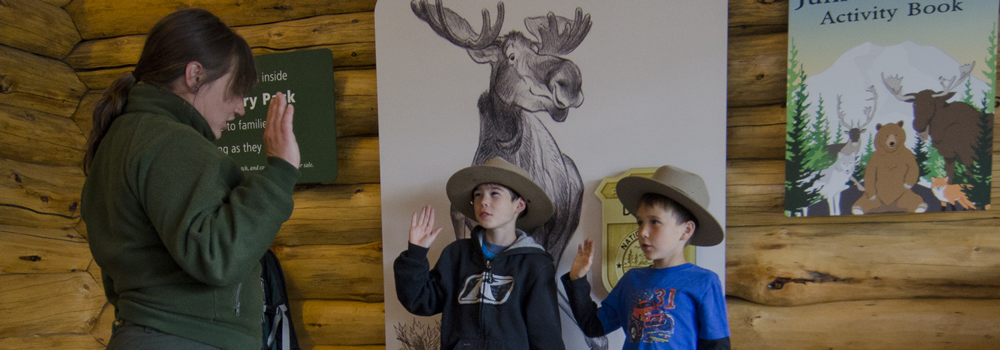
Second Year Of Every Kid In A Park Launched For 2016-2017
As part of President Obama’s commitment to protect our nation’s unique outdoor spaces and ensure that every American has the opportunity to visit and enjoy them, the Obama Administration has launched the second year of the Every Kid in a Park program, which gives fourth graders and their families free access to federal lands and waters nationwide for a full year.
Fourth graders can visit the Every Kid in a Park website to obtain a free pass that provides access to federally managed lands and waters – including national parks, forests, wildlife refuges and marine sanctuaries. The pass – which features a new design for this year’s students – is valid fromSeptember 1, 2016 through August 31, 2017 and grants free entry for fourth graders and up to three accompanying adults (or an entire non-commerical vehicle for drive-in parks) at more than 2,000 sites across the country.
“Over the past year, we have been able to introduce fourth graders and their families from all over the country to America's incredible national parks and public lands through the Every Kid in a Park initiative,” said Christy Goldfuss, managing director at the White House Council on Environmental Quality. “As we continue to build the next generation of outdoor stewards, we want to ensure that the pass inspires every American – kids, parents, students, teachers and more – to experience the incredible natural resources and historic sites that our country has to offer.”
“The Every Kid in a Park program is unlocking natural curiosity in children by encouraging them to explore our nation’s most spectacular places,” said U.S. Secretary of the Interior Sally Jewell. “We’re excited to welcome this year’s fourth graders and their families to our nation’s diverse parks, public lands and waters. From feeling the spray of a waterfall on their faces to peering at animals in their natural settings to understanding our rich history and culture, introducing children to their public lands can inspire a deep, lifelong connection to our country.”
The Every Kid in a Park program continues this year as a call to action for all children to experience America’s spectacular outdoors, rich history and culture. Today, more than 80 percent of American families live in urban areas, and many lack easy access to outdoor spaces.
By introducing fourth graders to public lands in their backyards and beyond at an impressionable age, Every Kid in a Park is part of a multi-pronged approach to inspire the next generation to discover all that our nation’s public lands and waters have to offer, including opportunities to be active, spend time with friends and family, and serve as living classrooms to build critical skills.
Fourth graders can log onto the Every Kid website at www.everykidinapark.gov and complete a fun educational activity in order to obtain and print their pass. Students can also trade in their paper pass for a more durable pass at participating federal sites nationwide.
Visitors to the expanded website will find several new features this year. Educators and community leaders can access educational activities, field trip options, information and tools in English and Spanish, and have the ability to print passes for their classrooms. Parents can find additional links to plan trips to nearby public lands. The website also contains a toolkit with resources for planning field trips, along with an extended list of public lands and waters to consider for field trips.
The Every Kid in a Park program will continue each year with the new class of fourth graders. After 12 years, every school-age child in America will have had an opportunity to visit their public lands and waters for free, inspiring the next generation to be stewards of our nation’s shared natural and cultural heritage.
The Every Kid in a Park program is an Administration-wide effort between the Department of the Interior, the Department of Agriculture, the Department of the Army, the National Oceanic and Atmospheric Administration and the Department of Education.
The program is part of an overall strategy by the Obama Administration to engage young people from all ages and all backgrounds with the great outdoors. This strategy includes the 21st Century Conservation Service Corps, a bold national effort to put thousands of young people and veterans to work protecting, restoring and enhancing America’s public lands and waters. In addition, First Lady Michelle Obama’s Let’s Move! Outside initiative is committed to getting millions of young people to play, learn, serve and work in America’s great outdoors.
For more information, please visit www.everykidinapark.gov and follow the program on Twitter @everykidinapark, Facebook, Instagram and YouTube.

One of the photos in a new Smithsonian exhibit features a Junior Ranger joining the Park Service’s Jessica Keller to explore the corals of Little Africa, a pristine reef at Loggerhead Key in Dry Tortugas National Park/NPS, Brett Seymour
Planning A Family Trip To Denali National Park? This Guidebook Is For You!
While national parks often seem extremely user-friendly, having a guide to help figure out what to do and where to go is always helpful. And if you have a young family, a new guide can help you get more out of a trip to Denali National Park and Preserve in Alaska.
The guide, Denali With Kids, was jointly produced by the National Park Service and Alaska Geographic, which produces many interpretive materials for exploring the national parks within Alaska.

This free travel guide is designed for parents and guardians who are traveling to Denali and are hoping to make lasting memories. Denali with Kids unlocks Denali's secrets by covering everything from the best places to camp and hike with your family to important safety and logistical information. This guide not only serves to help you plan your trip, but also includes parent testimonies and fun family photos that will inspire you.
Denali has something for people of all ages.
- Live nearby or visiting in winter? Check out a map of winter trails.
- Read up on the top 10 fun activities for kids and families.
- Become a Denali Junior Ranger and check out the national Junior Ranger page for games and other cool activities.
- Borrow one of the Denali Discovery Packs, which are full of cool activities, suggested science experiments and other fun resources.
- Learn about dinosaur tracks, glaciers, and bears with Denali's fact sheets for kids.
- Find educational materials and curricula.
- Plan a field trip to the park
- Participate in summer youth camps
You can find a high-resolution, 9-meg version of the guide here.
A somewhat lower-resolution 5-meg version can be found here.
Move Over Baseball, National Parks Have Trading Cards, Too
People have been collecting stuff forever. When adults visit national parks, they can collect passport stamps or pamphlets. Children earn Junior Ranger badges, though getting one takes a lot more effort and time than a passport stamp.

There are baseball trading cards, and there are National Park Trading Cards/NPS
But there's something else out there to collect, too, and it looks a lot like baseball trading cards. Only these are more educational. Since 2011, select national parks have been giving out trading cards to young visitors. The program, launched at Richmond National Battlefield Park in Virginia, was designed to commemorate the 150th anniversary of the Civil War and to encourage families to visit multiple national parks.
'The program has grown,' says Mike Litterst, a public affairs specialist for the National Park Service who came up with the idea.
The first series of cards debuted in 2011 for the start of the 150th anniversary of the Civil War. The next year, new cards came in as the program expanded beyond the Park Service's Northeast and National Capital Regions.

Junior Ranger Program For Underwater Explorers
With so many units of the National Park System tied to water, it shouldn't come as a surprise that the Junior Ranger program has a category for Underwater Explorers.
Think about it: There are four national lakeshores (Pictured Rocks, Apostle Islands, Indiana Dunes and Sleeping Bear Dunes), and ten national seashores (Cape Cod, Fire Island, Assateague Island, Cape Hatteras, Cape Lookout, Cumberland Island, Canaveral, Gulf Islands, Padre Islands, and Point Reyes). With all that water, there is lots to do and learn.
"Perhaps the best-kept secret of our national parks is the underwater realm that they include: millions of acres of submerged lands, only a fraction of which have been explored by divers," says the Park Service. "From the geysers on the bottom of Yellowstone Lake and the coral reefs of the Dry Tortugas, the national parks have much to offer recreational divers."
To earn an Underwater Explorer patch, kids 7 through 14 have a 36-page color publication that explores the National Park System's ocean and freshwater resources through a variety of fun activities. Some of the activities have to be done in a park, but some can be done at home. For instance, there's a home project involving how water currents work, and one that shows you how to build a coral polyp at home.
Throughout the guide youngsters will learn about such things as kelp forests, coral reefs, scuba gear, sharks, sea turtles, and many other water-related topics in an approach that offers fun and education for the entire family. There are word searches, mazes, word jumbles, and coloring pages.



